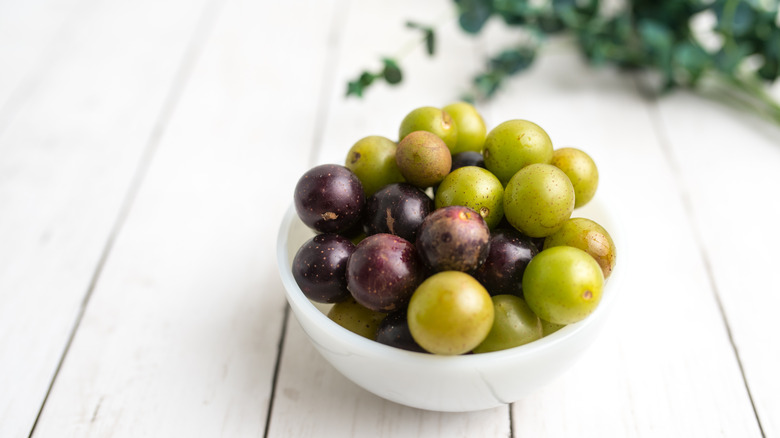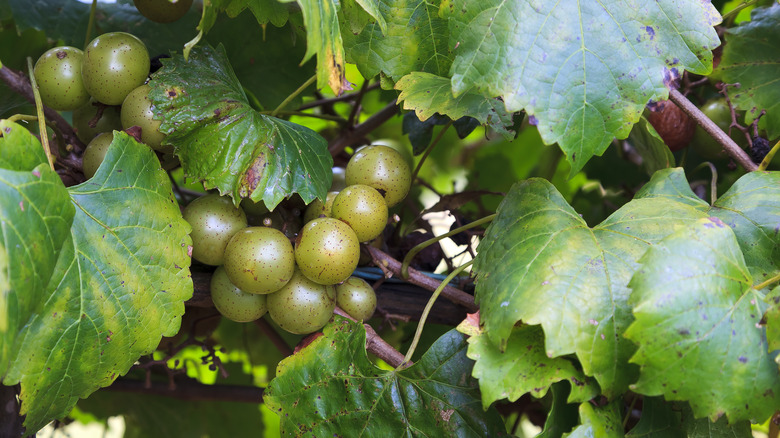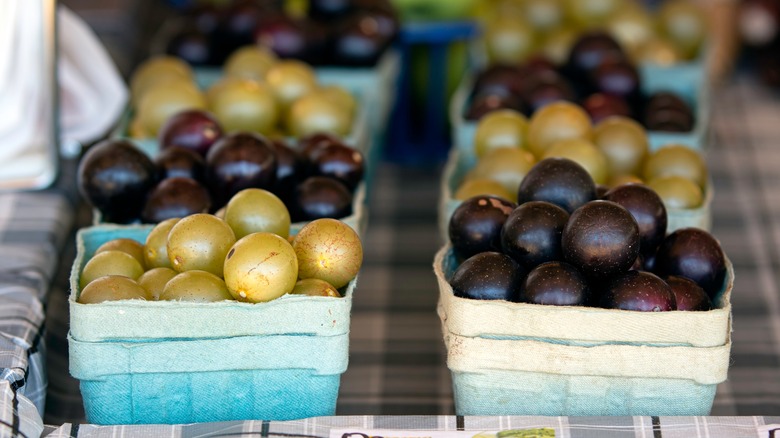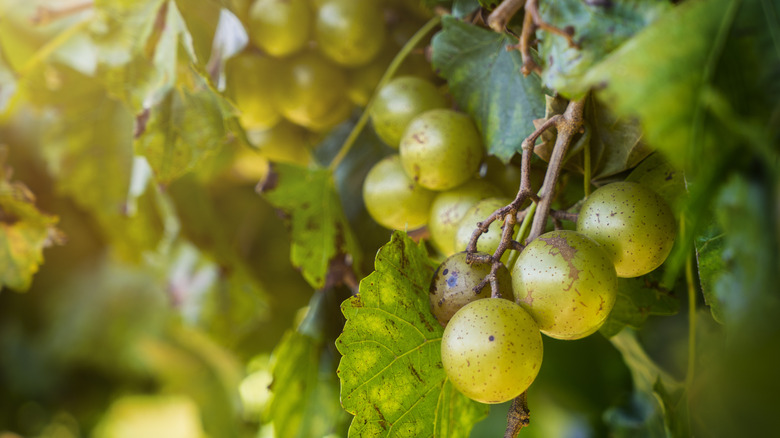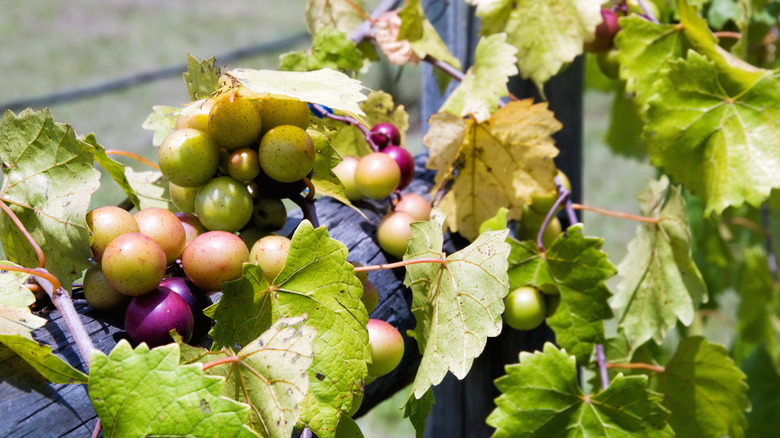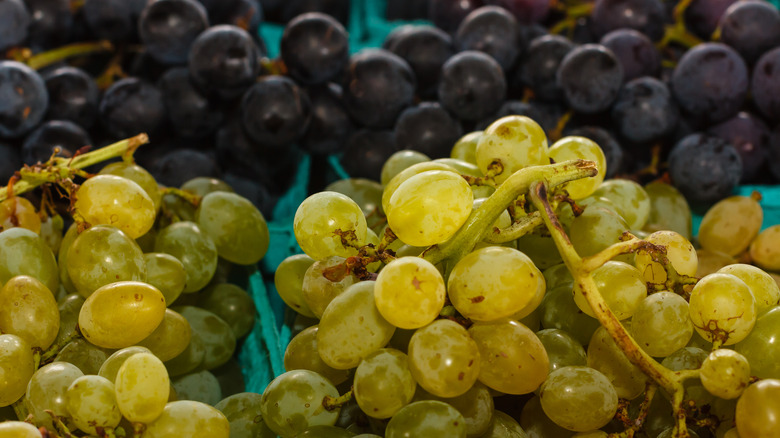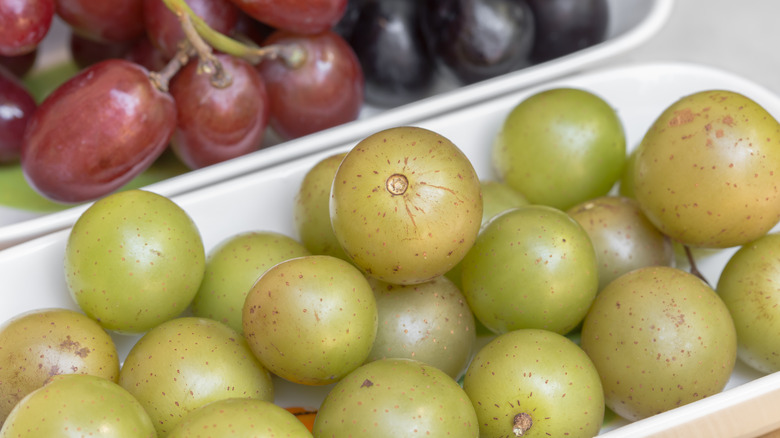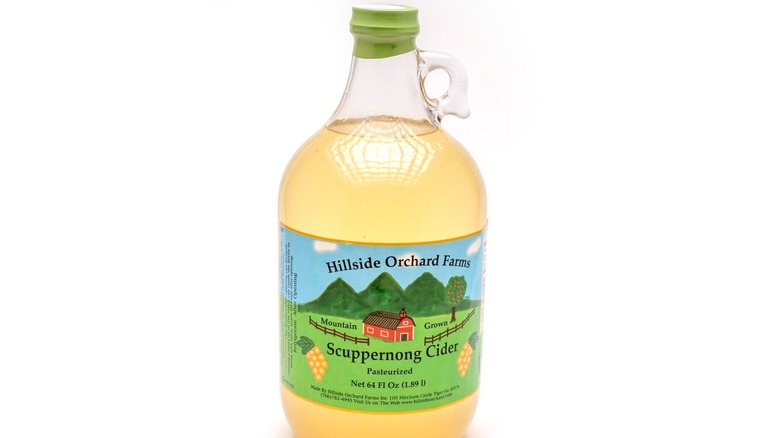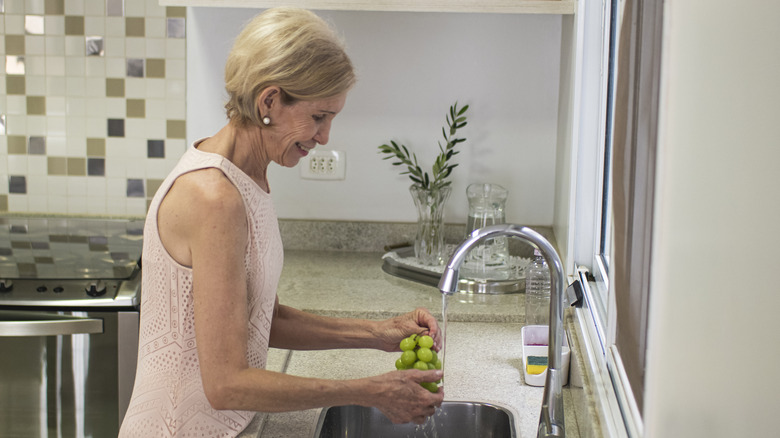What Are Scuppernong Grapes And Where Do They Come From?
If you live in the Midwest, out West, or really anywhere but the South, you may have never encountered a delightful and somewhat mysterious fruit known as the scuppernong grape. With a name that might easily fit in a whimsical children's story or a fanciful verse from Lewis Carroll's "Jabberwocky" poem, these grapes may initially seem like a figment of the imagination. However, the reality is as intriguing as the moniker suggests. Scuppernong grapes are not just a playful anomaly in the world of fruit; they are a culinary treasure steeped in history and unique flavors.
Originating from the lush vineyards of the Southeastern United States, scuppernong grapes are as rich in heritage as they are in taste. These grapes, one of the types of grapes stemming from the muscadine family, are known for their distinctively sweet flavor, thick skin, and hearty resilience, making them a beloved staple in the regions where they thrive. As soon as you experience the burst of flavor from your first bite, the unique name becomes an endearing term for a grape that leaves a lasting impression.
What are scuppernong grapes?
Scuppernong grapes, with their distinctive name and characteristics, stand out as a unique type of seeded grape, particularly known for their noticeably thick skin. These grapes diverge from the typical green grapes one might pick up during a regular grocery store visit, offering a semi-sweet flavor profile, while still maintaining a color resemblance. Historically, in the warm and sun-drenched backyards of Florida, many residents found comfort in the shade provided by the robust scuppernong vine, a testament to its hardiness and adaptability as a native plant in the region. This vine not only offers shade but also brings with it a touch of natural beauty and a sense of southern charm.
In Florida, these grapes have been a staple, but their appeal stretches beyond state lines. They hold a particularly special place in North Carolina, where they have been embraced with such affection that they were designated as the state fruit in 2001. This honor highlights the scuppernong's historical and cultural significance in the region. It is also a recognition of the grape's role in the state's agricultural heritage, particularly in the areas surrounding the Scuppernong River, after which they are named.
The scuppernong's history in the United States is deeply rooted, in fact. They are notably the first grape variety to undergo active cultivation in the country. The name scuppernong itself has historical roots, deriving from the Algonquian word askuponong.
Where are scuppernong grapes produced?
Native to the lush landscapes of the Southeastern United States, scuppernong grapes are a regional treasure, cultivated with care on both expansive commercial farms and in the more intimate settings of smaller, local farms throughout the area. The harvest season for scuppernongs typically extends from the balmy days of late summer into the crisper, golden-hued early fall.
For those residing in areas graced with milder winters and consistently warm temperatures, growing scuppernong vines can be a rewarding endeavor. These vines thrive under such climatic conditions with the optimal time for planting these vines being during the latter part of fall extending into winter.
When choosing a spot for planting, seek out locations with abundant sunlight, for it plays a crucial role in the growth and development of the grapes. Equally important is ensuring proper drainage in the chosen area. Vital for the health of the vines, proper drainage prevents waterlogging and associated root issues, thus fostering a healthy and productive grapevine.
Scuppernong grapes vs. muscadine grapes
Understanding the distinction between scuppernong and muscadine grapes can indeed be a bit perplexing, especially since these names are frequently used interchangeably in casual conversation. To clarify, muscadine grapes represent a broader category of grapes, a diverse group that includes various types and flavors. Within this family, scuppernongs are a distinct variety.
Muscadine grapes are sweet, richly juicy, and sometimes even carry a hint of tartness, a delightful combination that tantalizes the taste buds. Scuppernongs, while still sweet, typically have a subtler sweetness. This nuanced difference in sweetness sets the scuppernong apart, offering a different flavor profile for those who prefer a less overtly sweet grape.
In terms of physical characteristics, both scuppernong and muscadine grapes share some common traits, such as having large seeds and thick skins. However, the scuppernong distinguishes itself with skin that is marginally thinner compared to the typical muscadine, and its seeds are somewhat smaller.
How do scuppernong grapes taste?
Enjoying scuppernong grapes involves a bit of preparation to savor their unique taste. To enjoy these grapes fresh, begin with a gentle but firm bite and use your teeth to tear through the grape's thick, resilient skin carefully. The next step is to separate the flesh of the grape from the skin and the seed within.
The flesh of the scuppernong grape is where its sweetness resides, a natural burst of sugary delight. This sweetness is balanced by the slightly acidic nature of the skin, adding a depth of flavor that enhances the overall tasting experience. However, you must also contend with the bitter pit, which, while not really meant for consumption, plays its part in shaping the grape's unique character. To make the snacking process more comfortable and avoid irritation from the skin, applying a thin coat of petroleum jelly to your lips and chin can be helpful.
How to cook with scuppernong grapes
Making jelly from scuppernong grapes is a popular and straightforward way to enjoy their unique flavor in a different form. Begin by boiling the grapes with a small amount of water. This process helps the skins to soften and release their juicy pulp. It's helpful to mash the grapes occasionally during this stage, aiding in the extraction of their flavors. This approach conveniently omits the need for peeling or pitting the grapes, making the preparation easier and more efficient.
Once the boiling is complete and the skins, pulp, and seeds have been adequately broken down, the next step is to strain them out. This leaves behind the clear grape juice, which is the base of your jelly. In this juice, mix sugar and a dash of lemon, heating the combination until the sugar completely dissolves. The lemon not only adds a tangy flavor but also helps to balance the sweetness of the jelly. Finally, stir in liquid pectin to the mixture. This is what transforms your liquid concoction into the jelly's final, spreadable form that's ready for canning.
Of course, for something a little less common, consider soaking your grapes in whiskey and cinnamon for a boozy snack. You'll want to plan in advance so that your grapes have enough time to take in the whiskey for the ideal cocktail hour snack.
Where to buy scuppernong grapes
Scuppernong grapes are widely available in the areas where they flourish, making them a convenient and popular choice for locals. These grapes can typically be found in a variety of settings, including neighborhood grocery stores, where they're often a seasonal highlight. Farmers' markets are another common venue, offering a chance to purchase scuppernongs directly from the growers and providing insights into the grape's origins and cultivation practices.
Orchards, however, are perhaps the most engaging places to source scuppernong grapes. Many of these orchards offer a unique U-Pick experience, allowing visitors to handpick grapes straight from the vine. This activity is not only a delightful outing for families, but it also provides a deeper appreciation for the fruit and the effort that goes into growing them. To stay informed about these U-Pick events, which are seasonal and dependent on the grape's ripening schedule, we recommend following your favorite orchards on social media.
Nutritional information about scuppernong grapes
Scuppernong grapes, as a nutritious and delicious fruit, offer a variety of health benefits. Rich in essential vitamins, they provide a good dose of vitamin B, important for energy metabolism and maintaining a healthy nervous system, and vitamin C, known for its immune-boosting properties. These grapes are also a source of potassium and antioxidants. Additionally, while the seeds and pits of scuppernong grapes might not be enjoyable to eat, they contain resveratrol, a compound with antibiotic properties.
As a variety of muscadine grapes, a typical serving size of scuppernong grapes is about half a cup, which is approximately 16 grapes. This serving size amounts to roughly 55 calories. These grapes contain less than a gram of fat and provide just under a gram of protein, around 11 grams of carbohydrates for energy, and about 3 grams of dietary fiber, which is beneficial for digestive health.
Varieties of scuppernong grape products
If you're interested in enjoying scuppernong grapes in a form other than fresh fruit, there are plenty of options available, especially if you live close to where they're grown. Local grocery stores in these areas often carry a variety of products made from scuppernong grapes. Additionally, orchards that offer U-Pick experiences frequently also sell a range of delicious scuppernong-based products.
For those who live farther from the South, the convenience of online shopping brings these products right to your doorstep. For instance, Hillside Orchard Farms in Georgia offers an array of scuppernong products, including scuppernong cider, jelly, and preserves, all made fresh and shipped directly from the orchard.
For a more adventurous taste experience, Duplin Winery in North Carolina, South Carolina, and Florida offers a selection of scuppernong wines. These offerings include a sweet scuppernong wine, a scuppernong blush, and even an alcohol-free version. Additionally, products like scuppernong jelly from The Dutch Kettle are available on Amazon, providing easy access to these regional flavors regardless of your location.
How to store scuppernong grapes
Since not all grocery store produce is washed before it reaches shelves, taking a few extra moments to wash your scuppernong grapes is a crucial first step to enjoying them safely. However, it's advisable to hold off on washing your grapes too far in advance from eating them, as washing them too soon can be counterproductive and speed up the spoiling process.
Instead, the best practice is to move directly to storing them in the refrigerator. Refrigeration is key in slowing down the ripening process, helping preserve the grapes' freshness and flavor for longer. However, it's essential to store them in a container that promotes adequate ventilation. Using a container that allows some air circulation is important as it prevents moisture buildup, which could lead to mold and spoilage.
When you're ready to enjoy your grapes, that's the time to wash them. Take them out of the refrigerator and give them a thorough rinse, removing the whitish wax that helps keep them fresh during storage. If your scuppernong grapes were acquired through a U-Pick experience, you might find a bit of extra care is needed to remove any dirt, stems, or leaves that might have accompanied them. Ensuring your grapes are clean improves their taste and contributes significantly to food safety for you and your family.
